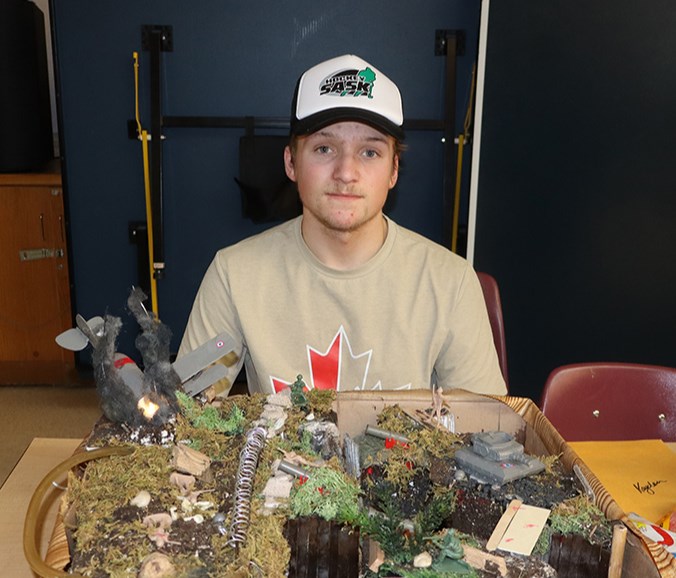CANORA - As the culmination of Olivia Gordon’s Canora Composite School History 20 class unit on the First World War, Gordon challenged the students to create Trench Warfare Museum diorama projects to demonstrate their understanding of “The Great War.”
Students were given a week of class time, amounting to about five hours, to work on their projects, as well as well as after school and at home as they saw fit. Students were given the option to either work in pairs or on their own.
On March 18, the projects were on display at the CCS Students Centre for viewing by other students and school staff, with the History 20 students available to answer questions.
Cody Vangen and Ira Mykytyshyn teamed up on their project, and said one of the things that impacted on them the most was the brutality of the war and “The front line barely moved more than a few metres for most of the war.”
Their display has the red model figures depicting Allied soldiers, and the fighters from the Central powers were in grey. The scene is in the early spring, with lots of mud and burnt cotton balls to show the snow was discoloured by the fighting.
“During the First World War, trench warfare became the dominant form of combat on the Western front. Soldiers lived and fought in deep trenches that stretched for miles, facing extreme hardships every day. Our diorama represents a typical trench, showing the difficult conditions that soldiers endured.
“The trenches were often muddy and waterlogged, making movement difficult. Soldiers spent long hours standing in cold, wet conditions, which could lead to serious health issues such as trench foot, a painful and sometimes deadly condition caused by prolonged exposure to moisture. Food was scarce, and soldiers often ate simple, bland meals while dealing with the stench of unclean living spaces.
“The ladder in the display helps show how quickly soldiers would charge over the top, often fighting for mere meters of land with many dying.”
Meekah Unick and Katie Hauber pooled their talents on their version of trench warfare.
“The Western Front ran 700 km from the Belgian coast down to the border of Switzerland. The fight between the Allied and Central armies at the Western Front largely impacted the course of the war. Around 1.7 million Allied soldiers, as well as around 2.1 million Central soldiers, gave their lives on the Western Front.”
Unick and Hauber estimate it took about six to seven hours to create their diorama. It demonstrates how the trench system set up by the allies was designed to make trench warfare more bearable, and fruitful. Soldiers would spend four to six days on each line, before moving to another.
“The first trench, closest to the battlefield, was called the frontline trench. The conditions were the worst in this trench. The soldiers had to be on constant watch, only sleeping for a few hours at a time during the day.”
Brutal conditions resulted in rampant disease and infection among the solders. Unick and Hauber said they discovered that soldiers were more likely to be weakened or die from infection/disease in the front line trench than from a bomb.
“The second line was called the support trench. Its main role was as a second line of defence if the front line was under attack. The soldiers from the front line would fall back to fight with the soldiers already positioned in the second line. The support trench held extra supplies and artillery for the first line.
“The last line was called the reserve trench. This trench was the last line of defense and furthest away from the battlefront These trenches were shallower and soldiers that resided here could eat hot meals, bathe, get clean clothes, and sleep. You could find off-duty soldiers playing games and getting some well-needed rest here.”
Connecting the three main trenches were smaller, shorter trenches known as communication trenches. These were used for messengers and for soldier rotations between trenches.
Kayden Harder chose to go solo on his project, focusing on the later stages of the war in 1917. He used plastic to make a plane that is shown in the display after a crash, and also built a model tank that has the curved exterior more commonly seen later in the war.
“You can see casualties covered in blood in my project,” said Harder. “Barbed wire is used around the trenches for protection. The display also has water, dirt, fake sandbags and even miniature rats, which, in some cases, grew to be as big as cats during the war. The rats had an infinite source of food and shelter because thousands of soldiers were living in filthy circumstances, which allowed them to grow quickly. More than just a nuisance, the rats worsened the already awful conditions by spreading illnesses and carrying diseases like typhus. They also chewed on troops' possessions and spoiled supplies. The fact that they occasionally consumed the corpses of fallen soldiers is maybe the most upsetting, as it caused a terrible psychological impact on those who saw it.”
Harder worked on his project on and off for several weeks, both in school and at home. He added that during the trench warfare, there were frequent stalemates, resulting in prolonged and taxing combat with significant losses.
“Trench foot was a serious illness brought on by extended exposure to the cold, damp, and unhygienic conditions found in the trenches,” continue Harder. “Infections, numbness, swelling, and in extreme situations, amputation were the results.
Teaming up on their project, Andrew Owchar and Wyatt Wolkowski created a display of Allied trenches protected by barbed wire borders. The popsicle sticks used for wood in the display were stained to recreate the old, rotten look created by trench warfare.
“Our display shows the harsh, difficult conditions soldiers faced in The Great War. We have two big cannons in the middle of the diorama on either side of the trench system, which symbolizes artillery’s significant role in the war. Their location highlights the emphasis placed on long-range fire in penetrating the enemy lines and the constant threat of shelling that soldiers faced.”
Owchar and Wolkowski estimated they completed the project in about 16 hours. The soldiers all represent various aspects of front-line life.
“Some are loading or sighting the guns, but the majority are engaged in communication or watching for enemy attack. The exhaustion etched on the soldiers' faces and the muddy, close confines of the trenches speak to the daily difficulties of trench life for extended periods.”
Barbed wire around the trench display shows an extra measure of defense.
“The wire is twisted and sharp, and any attempt crossing it would be dangerous. This element of the diorama is a grim reminder of the stagnation of trench warfare, where soldiers were often trapped in their trenches and could not advance due to the fortified positions on both sides.”
Deciding on the solo approach for his project, Lucas Biletski created a multi-level display that “shows how technology changed throughout the time the First World War was happening.
“In 1915, Germans started using poison gas,” said Biletski, “but poison gas was one of the least effective new technologies mostly because the wind would often make the gas shift back towards the soldiers that threw it in the first place. Also, with new technology, mostly everyone started using gas masks, which are shown in the trench on one of the soldiers in the diorama.
“In 1916, the British introduced the armored tanks with mounted machine guns, which you can see on the upper level of the diorama. The first tanks moved slowly and broke down a lot but it still freaked the Germans out.
“By the end of the war both sides used aircraft in attacking each other, which is shown in the display with the jet on the popsicle stick at the top of my trench.”
Biletski estimates it took him about seven or eight hours to complete his diorama.
”The soldiers lying down on the top are snipers and next to them are lookouts with binoculars.”
Materials utilized in the project included sawdust to represent sand and dirt, while model sandbags are used as the bases for mounting machine guns.
Olivia Gordon said this is the second consecutive year she has assigned this trench warfare project to her History 20 class, and “The students continue to amaze me with their creativity. In a world influenced by AI, this assignment provides a challenge, encouraging students to independently apply the knowledge we’ve studied to complete their work entirely on their own.”
Gordon said a number of Grade 5 students visited the trenches before the presentation on March 18, making a lasting impression on at least one of them.
“One Grade 5 student was so inspired that he went home and created his own trench diorama. He brought it to school to show the Grade 11s and even joined us during our presentation with his trench. This experience allowed my Grade 11 students to see firsthand the positive impact they have as role models for younger students.”
During the viewing of the dioramas on March 18, visiting staff and students were directed to vote for their favourites with popsicle sticks. The winner was Kayden Harder.
Gordon believes this project will help the Grade 11 students become better people.
“It challenges their creativity, provides hands-on learning about the harsh conditions of war. It deepens their understanding of the impact trench warfare had on soldiers and encourages them to put forth their best effort and further develop teamwork skills.”
Don't count on social media to deliver your local news to you. Keep your news a touch away by bookmarking Canora Courier's homepage at this link.
Bookmark SASKTODAY.ca, Saskatchewan's home page, at this link.




